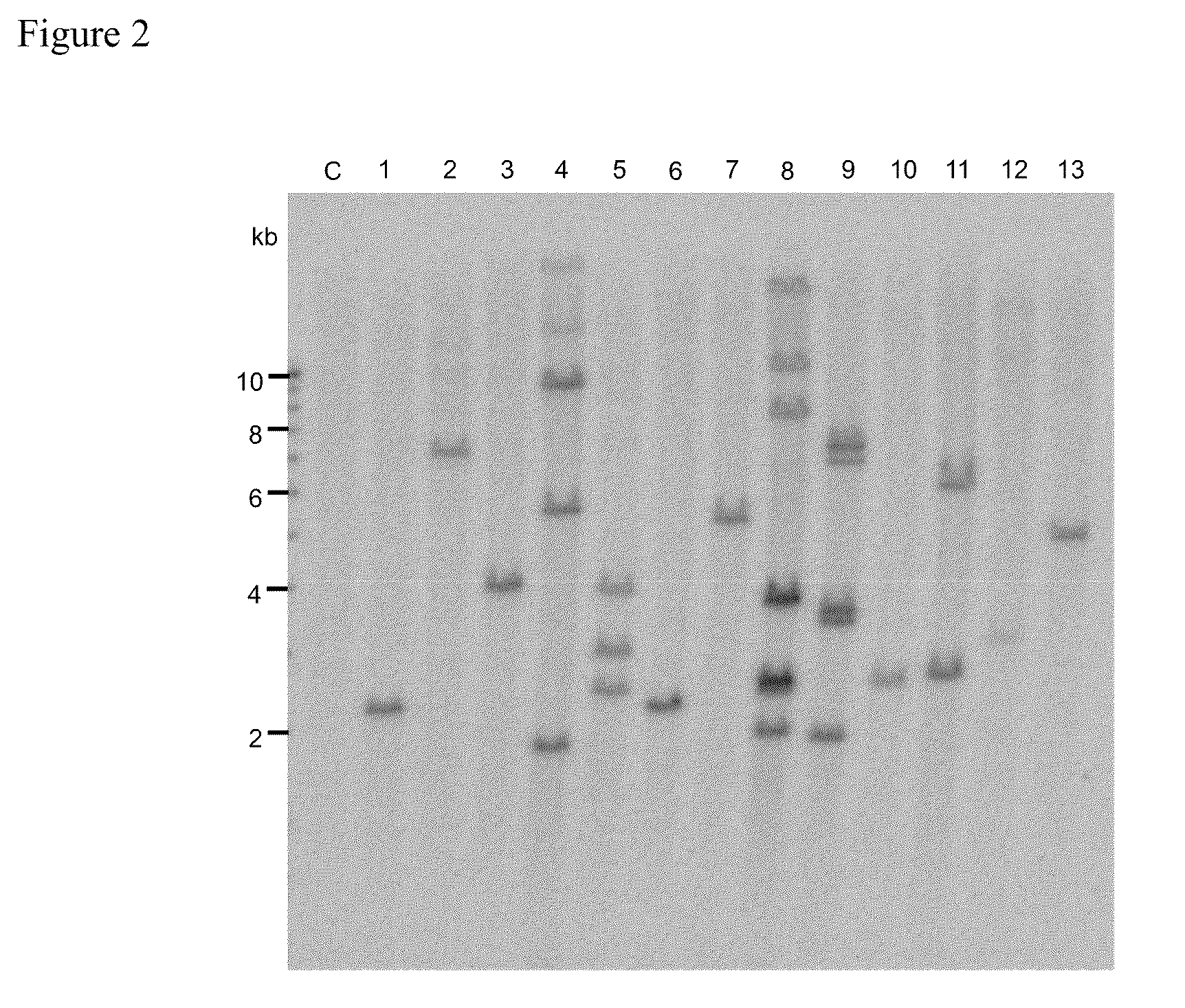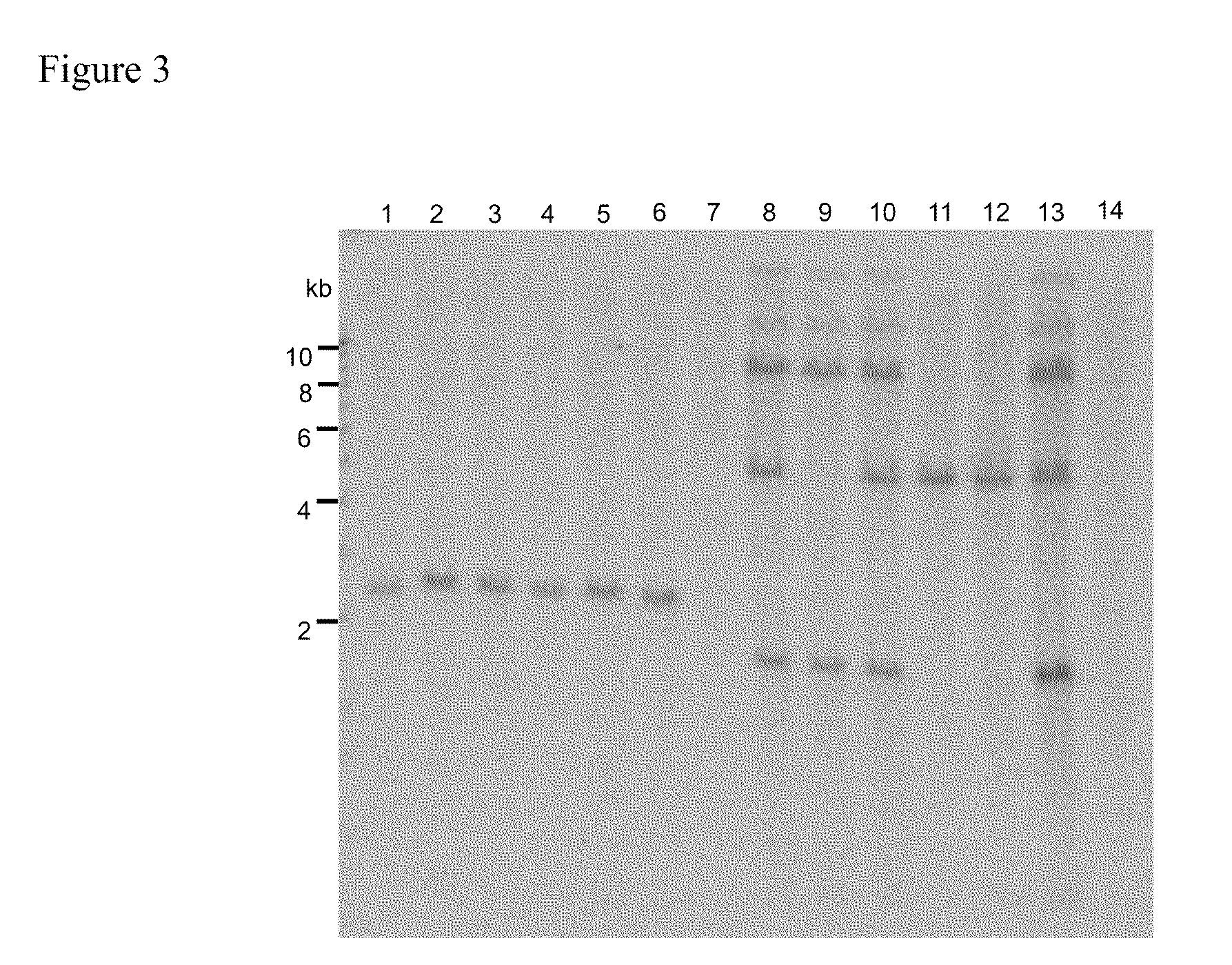Agrobacterium-mediated method for producing transformed maize or rice
a technology of agrobacterium and agrobacterium, which is applied in the direction of plant genotype modification, fermentation, biochemistry apparatus and processes, etc., can solve the problems of not indicating t-dna integration into nuclei, no whole plant was regenerated from these calli, and malformations and sterility of the transformed plant, etc., to achieve the desired plant. stable and efficient transformation
- Summary
- Abstract
- Description
- Claims
- Application Information
AI Technical Summary
Benefits of technology
Problems solved by technology
Method used
Image
Examples
example 1
Gene Expression in Whole Plants Regenerated without Selection from Immature Maize Embryos Inoculated in a Standard Manner
[0208]1. Material and Method
[0209]Maize (variety: A188) immature embryos (1.0 to 1.5 mm in size) at 7 to 14 days after pollination were aseptically collected and washed once with LS-inf liquid medium (Ishida et al., 1996), followed by pretreatment (thermal treatment at 46° C. for 3 minutes and centrifugation at 20,000×g for 10 minutes) to increase gene transfer efficiency for transformation enhancement (Hiei et al., 2006). In LS-inf liquid medium containing 100 μM acetosyringone, Agrobacterium strain LBA4404 (pSB134) (Hiei and Komari, 2006) was suspended at about 1.0×109 cfu / ml to prepare an inoculum.
[0210]The thermally-treated and centrifuged immature embryos were mixed with the inoculum, vortexed for 30 seconds, and then allowed to stand for 5 minutes at room temperature. The Agrobacterium-inoculated immature embryos were placed, with their scutella facing up, o...
example 2
Gene Expression in Whole Plants Regenerated without Selection from Immature Maize Embryos Inoculated by the Drop Method
[0224]1. Material and Method
[0225]An inoculum (1 ml) of Agrobacterium strain LBA4404 (pSB134) prepared in the same manner as shown in Example 1 was supplemented with about 80 mg of hydroxyapatite (Bio-Rad). Immature embryos were subjected to pretreatment (thermal treatment at 46° C. for 3 minutes and centrifugation at 20,000×g for 10 minutes) to increase gene transfer efficiency for transformation enhancement.
[0226]After the above treatment, the immature embryos (variety: A188) were placed, with their scutella facing up, onto a coculture medium containing dicamba at a concentration of 1.5 mg / l in LS-AS medium (Ishida et al., 1996; solidified with 8 g / l agarose) which had been prepared to exclude 2,4-D and contain 5 μM AgNO3 and 5 μM CuSO4.
[0227]After shaking with a vortex mixer to uniformly disperse hydroxyapatite in the inoculum, 5 μl of the inoculum was added drop...
example 3
Effect of Auxin in Coculture Medium on Gene Expression in Whole Plants Regenerated without Selection from Immature Maize Embryos
[0239]1. Material and Method
[0240]Maize (variety: A188) immature embryos (1.0 to 1.5 mm in size) at 7 to 14 days after pollination were aseptically collected and washed once with LS-inf liquid medium, followed by pretreatment (thermal treatment at 46° C. for 3 minutes) to increase gene transfer efficiency for transformation enhancement. In LS-inf liquid medium containing 100 μM acetosyringone, Agrobacterium strain LBA4404 (pSB124) (Komari et al., 1996) was suspended to prepare an inoculum.
[0241]The thermally-treated immature embryos were mixed with the inoculum, vortexed for 30 seconds, and then allowed to stand for 5 minutes at room temperature. The Agrobacterium-inoculated immature embryos (24 in total) were placed, with their scutella facing up, onto a coculture medium containing dicamba (3,6-dichloro-o-anisic acid) or picloram (4-amino-3,5,6-trichloropi...
PUM
| Property | Measurement | Unit |
|---|---|---|
| concentration | aaaaa | aaaaa |
| concentration | aaaaa | aaaaa |
| temperature | aaaaa | aaaaa |
Abstract
Description
Claims
Application Information
 Login to View More
Login to View More - R&D
- Intellectual Property
- Life Sciences
- Materials
- Tech Scout
- Unparalleled Data Quality
- Higher Quality Content
- 60% Fewer Hallucinations
Browse by: Latest US Patents, China's latest patents, Technical Efficacy Thesaurus, Application Domain, Technology Topic, Popular Technical Reports.
© 2025 PatSnap. All rights reserved.Legal|Privacy policy|Modern Slavery Act Transparency Statement|Sitemap|About US| Contact US: help@patsnap.com



